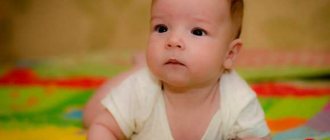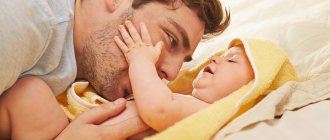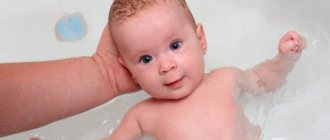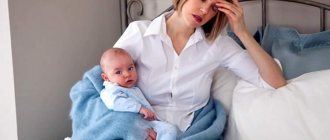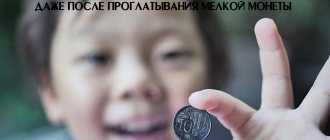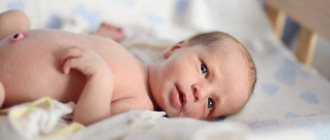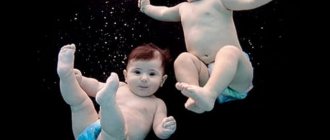One day my son fell on the street and hit the back of his head. At the same time, there was even an abrasion with slight bleeding, which was successfully stopped. Everything worked out without drug treatment.
Once, when my friend and her daughter were returning home from kindergarten (in winter), they slipped, fell and hit the back of their heads. Everything turned out okay for the mother, but the girl was diagnosed with a concussion and appropriate treatment was prescribed.
There was also a case with a neighbor boy. He was visiting his grandmother and one day she washed the floor in the hallway and told him not to leave the room until it was dry. But then the cat Vaska jumped out from under the sofa and ran into the corridor. Sashenka, who had been trying to get the cat for a long time, ran after him, forgetting about his grandmother’s warning. He slipped, fell and hit the back of his head hard. At that moment a big lump jumped out, he cried for about five minutes without stopping, either from pain, or from resentment that Vaska managed to escape again. Mom took Sasha to an appointment at the clinic, where, on the doctor’s recommendation, they underwent x-rays. Fortunately, everything worked out fine. They were prescribed medications to resolve the lump.
Why does a small child often hit his head: reasons
There are many reasons why a child often hits his head:
- Undeveloped nervous system
- Large head size and weight
- Insufficient coordination of movements
- Carelessness
It happens that the baby hits his head against the wall on purpose and intentionally. There are a number of reasons for this:
- A way to know yourself
- Rage and anger
- Way to get attention
- Manipulation
- Health problems
Please note that if a toddler hits his head on the bed before going to bed, this is an alarming signal. In this way the baby tries to relax. This indicates possible disorders of the central nervous system.
Why does a small child often hit his head: reasons
Treatment tactics for TBI in infants
At the slightest suspicion of a traumatic brain injury, the infant should be hospitalized in a hospital for examination by neurosurgeons and neuropathologists. To confirm the diagnosis, the following tests and studies are performed:
- Ultrasound of the brain.
- Computed tomography or magnetic resonance imaging.
- Electroencephalogram.
Once the diagnosis is confirmed, the baby is prescribed appropriate medications, physiotherapy and a special regime. Correctly formulated therapy helps to heal the injury with minimal consequences.
A child fell on the back of his head: what to do, what to pay attention to, first aid, consequences
It is necessary to provide the child with first aid:
- Assess the site of injury and see if there is bruising
- If yes, then apply ice or a cold bottle to this area for 5 minutes
- Treat the injury site with an antiseptic
What to pay attention to:
- If your baby gets sleepy, don't let him fall asleep. This will help identify behavioral disorders, if any.
- Child behavior. He shouldn't be constantly nervous and hysterical
- Lack of appetite and poor coordination of movements
- Nausea and vomiting. See a doctor urgently
All these symptoms indicate a concussion, go to the doctor.
A child fell on the back of his head: what to do, what to pay attention to, first aid, consequences
Falling off the couch
Young parents often underestimate the capabilities of their baby. They allow themselves to leave the baby on the sofa unattended. Already from 4 months the child is actively moving and trying to roll over. At the same time, the baby gradually begins to crawl. At this age, the baby needs an eye and an eye if the parents want to protect the child from injuries and bruises.
Probably in every family there was a case when, at the age of, say, 6 months, a child fell from the sofa and hit his head. Komarovsky believes that such an event is almost inevitable. All children under 1 year of age often fall out of bed. Kids cannot yet assess the danger of their actions and in a split second they roll to the floor. Even a very attentive mother may not notice the fidgety baby, turning away for the bottle.
In children of the first year of life, the brain and central nervous system are actively developing, and the bones of the skull are not yet strong enough and are not tightly connected. This increases the risk of injury from a fall that results in traumatic brain injury. Therefore, it is important to prevent a child from falling and hitting his head at 6 months. Komarovsky warns of dire consequences. The baby can get a concussion and even an open head injury.
A child hit his temple on a corner: what to do, what to look for, first aid, consequences
This is quite dangerous, as it can cause the development of a brain hematoma. In order to prevent the condition from worsening, it is necessary to monitor the child and, if there are deviations in behavior, immediately go to the doctor.
First aid:
- Apply ice or cold
- Treat the injury site with an antiseptic
- Try to provide peace, but not put you to sleep
Alarming symptoms:
- Vomiting, nausea
- Dizziness
- Convulsions
- Loss of consciousness
- Hysterics
A child hit his temple on a corner: what to do, what to look for, first aid, consequences
How to give first aid
What to do as first aid to a child who has hit the back of his head:
- Never underestimate the condition of the victim!
- If he falls out of bed and hits himself but is conscious, place him horizontally on his back with his head slightly elevated.
- Try to calm your child down and communicate with him.
- If the child is sleeping, it is necessary to regularly wake him up and check his state of consciousness.
- Do not give your baby food, painkillers, or sedatives.
- Provide thermal comfort; the victim should not become hypothermic or exposed to the sun.
- Place the victim in a stabilized position.
- In case of unconsciousness, it is necessary to ensure airway patency and call an ambulance.
Important! For any head or neck injury, you should consult a doctor.
How to treat a wound on the back of the head:
- It is necessary to cover the wound with a sterile bandage (it should always be present in the first aid kit). These bandages contain an absorbent pad with long rolls of bandage on both ends to hold the absorbent pad in place.
- Open the bandage wrapper and unroll it to the absorbent pad.
- The pillow will be large and square, so you may need to fold it in half. Cover the wound with it.
- Ask your child to hold the bandage.
- Use long bandages attached to each end and wrap around the child's head, securing the bandage.
- Tie the ends of the bandages.
- Make sure the bandage does not fall off or cover your eyes.
- Reassure the child and promise to take care of him.
A child often hits his head: Komarovsky
Dr. Komarovsky believes that children hit their heads quite often. By the age of one year, 80% of all falls and head impacts go away without leaving a trace and do not require medical intervention. If the child fell, cried a little and calmed down, then there is no reason to worry. You need to ensure quiet games and monitor the condition.
Alarming symptoms, according to Komarovsky:
- Vomiting more than once
- Impaired coordination of movements
- Convulsions
- Speech Impairment
- Loss of consciousness
- Loss of sensation in one of the limbs
- After hitting your head, bruises appear under your eyes
- Discharge of blood or colorless fluid from the ears or nose
A child often hits his head: Komarovsky
Head hits are a common occurrence for children. Your task is to monitor the child’s condition and, if necessary, go to the emergency room.
Physiological features of the child's brain
A child's head has a slightly different structure than an adult's. The baby's skull bones are soft and flexible. This means that it is difficult to break the skull in a collision with a hard surface. During an impact, the elastic bones move and return to their original position.
Another important feature of the child’s brain is its immaturity and high content of cerebrospinal fluid. A child's head can withstand impacts much more easily.
Doctors rarely diagnose a traumatic brain injury or concussion when a child falls and hits their head. Komarovsky talks a lot about injuries and teaches parents to recognize dangerous symptoms. A well-known pediatrician gives valuable recommendations and tells how to properly provide first aid for various head injuries.
Fear has big eyes, or How to properly assess damage
So, the irreparable happened - the baby somehow managed to fall and is now sobbing inconsolably, notifying the entire neighborhood about what happened. The first thing a mother should do is pull herself together! Of course, sometimes this is not as easy to do as it seems, especially if the child has cut soft tissues and the blood is gushing out quite actively - the sight of a bloody child can make even the most balanced parents faint. However, panic in adults is perhaps the first cause of serious consequences of injury, which could have been avoided with proper and timely first aid.
To understand how hard a child fell, you should first calm him down at least a little. This needs to be done confidently and calmly: while explaining to the baby that everything will be fine and the pain will soon subside, try to wipe away his tears as much as possible and shake off any adhering dust and dirt (if the fall occurred on the street).
You can also understand how painful the fall was by the way you cried. If the baby immediately began to scream and burst into tears, it means that most likely he did not fall too seriously, and a short-term hysteria is just the result of fright. But if the crying appears with a delay, albeit a slight one, and does not stop for more than 5 minutes, the pain is really quite severe and the baby urgently needs help.
If there is bleeding, be sure to find its source and stop the bleeding. In most cases, a bandage and hydrogen peroxide will be enough for this, but if the damage is serious, it will still not be possible to do without the help of doctors.
Once the bleeding has stopped and the child is calm, place him on a horizontal surface and carefully examine him for any external signs of injury. The head should be examined especially carefully - bumps and bruises can be the “first sign” of concern, because even minor head injuries in childhood are quite serious. This is especially true for infants in the first year of life, since their skull bones have not completely fused. On the one hand, this feature allows you to protect them from cracks in the skull in the event of a minor fall, on the other hand, it increases the likelihood of brain injury.
Buy a protective bed rail
One way to protect a child one month and older from falling from sofas, beds and couches onto the floor is to install a special bumper. Such bumpers can be bought in children's stores.
The side is a rigid frame covered with mesh or fabric. It is attached to the bed in a special way and protects it from falling, even if the baby crawls to the edge. There are also models made entirely of wood or plastic and installed on the floor.
The cost of such children's barriers ranges from 2000 rubles to 6000-8000 rubles.
Most popular brands:
- Chicco;
- Tomy;
- Lindam;
- Safety;
- NewJoy.
When choosing a barrier, pay attention to the fastenings. They should be reliable and strong - the child should not unfasten them himself. As for the material, it is more practical to choose wooden or plastic models - they are easy to wash, and the baby will be able to sharpen his teeth on them if desired.
However, fabric sides are much safer. If a child rolls up to him in his sleep, he will not hit himself.
If the baby fell from the swing
Another dangerous place where small children are often injured is the playground. There are a lot of children gathering on the slide, who can not only fall themselves, but also push each other. Even in kindergarten, it happens that a child falls from a swing and hits his head. Komarovsky considers playgrounds to be a place of increased danger that requires constant supervision of children.
To prevent serious injuries, pediatricians advise parents of preschoolers to always stay close to the child on the playground and support the child with their hands when he climbs high structures. When a child has already learned to ride independently, one of the adults should still watch him and stay at a distance of several meters. This way you will be able to quickly react to the baby’s desire to make a dangerous movement, the results of which can be disastrous.
Head injuries from falls on playgrounds are more dangerous. All swings and slides are made of metal, which has an increased risk of injury. And if you take into account the concrete surface of the site, then you should not be surprised by the fact that the risk of seriously injuring your head is quite high.

